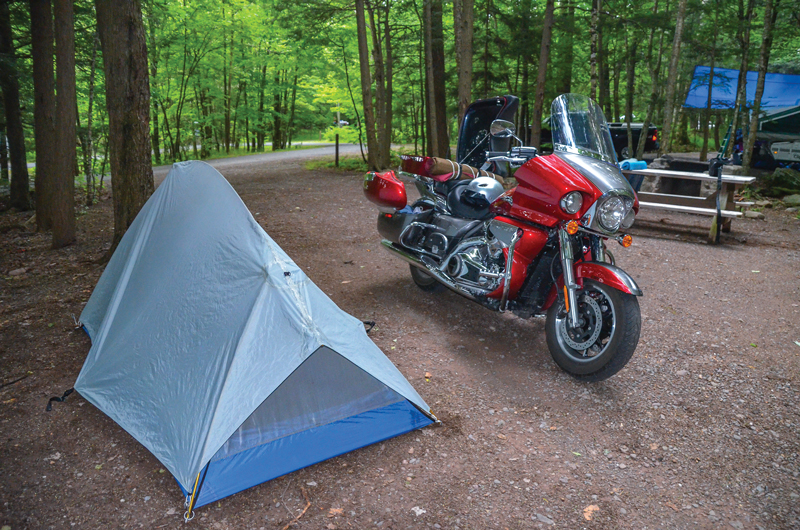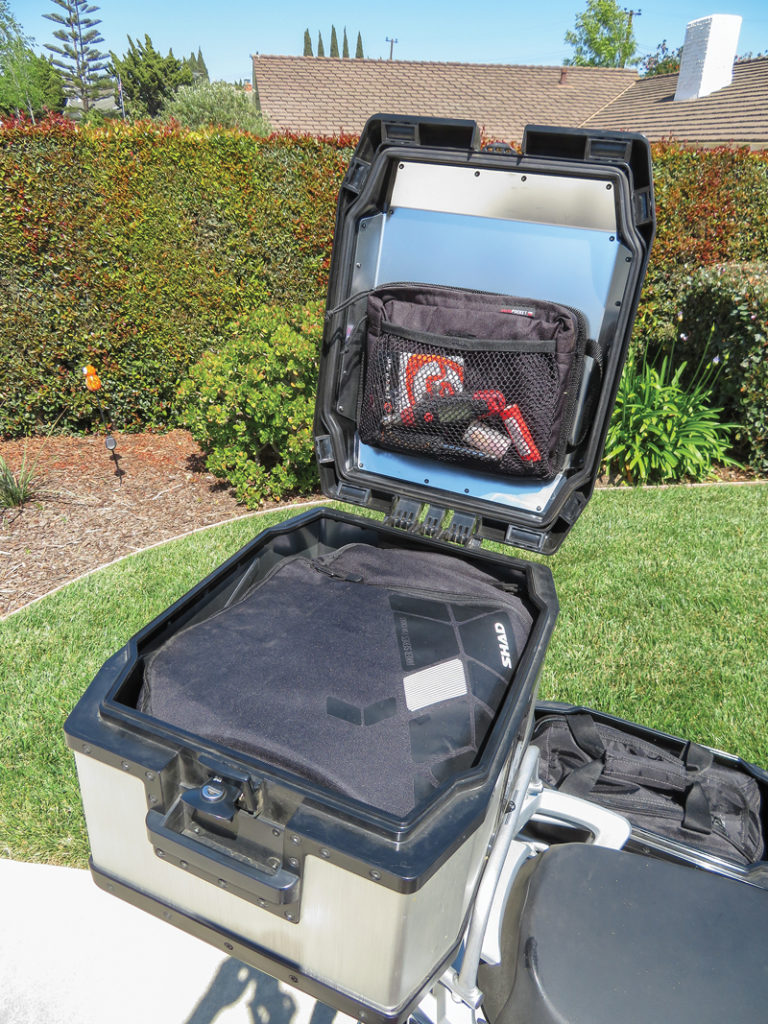
Everyone knows the potential benefits and joys of camping out. Spectacular unfiltered views of the sky, sunsets and stars, communing with nature and friends by the campfire and sharing simple, tasty meals surrounded by trees, wildlife, mountains or the open desert…it’s all out there. Camping avoids costly hotels, too, so you can ride longer for less, and it lets you plan riding routes into backcountry you might not otherwise be able to reach. The shared effort and cooperation of roughing it with friends also enhances your group’s camaraderie, creating stronger bonds and great memories.
Funny stories and great camping recipes from our Rider Magazine Camping Challenge!
Of course, camping is a bit more complicated than whipping out a credit card at the Dew Drop Inn. Everything we need and take for granted in our homes or in hotels has to come with you on the bike, right down to the roof over your head. Car campers have it easy–there’s generally plenty of room, so less thought has to go into what to bring. But despite a limited amount of space on a motorcycle, with a little forethought and ingenuity you can enjoy both a great ride and a memorable camping trip.
Check out the Top Ten Things You Shouldn’t Forget on Your Moto-Camping Trip.

Assuming you’re a total newbie to motorcycle camping, consider picking a spot for your first overnight that has water, toilets, trash cans, picnic tables, fire rings and/or grills, like an established campground. Dry, primitive camping can be awesome and the only kind available in some really wonderful places, but in addition to carrying your own water for washing and drinking, you’d be surprised how inconvenient the lack of a simple raised table can be for some people, not to mention doing your business in the bushes and packing out your trash. Of course, a dark pit toilet in a campground is still an adventure at 3 a.m., but at least you’ve got a door and somewhere to sit (just remember that if something falls in there, it’s probably staying!).

It also helps if there’s a camp store or host nearby who can provide bulky things like charcoal and firewood, which you can strap to the bike after it’s unloaded at the campsite. Depending on the motorcycle’s capacity and if you’re riding solo or two-up, you may also want to skip the pre-organized meals and simply buy something for dinner and breakfast at the closest store to the campground and bungee it on in some way. You’d be amazed how much space you can find when you’re hungry and thirsty! Bring or buy soft-sided insulated bags that fold flat for transporting cold beverages or hot food, and try to leave some space in your bike’s luggage for your purchases when you pack the bike at home.

How much and what type of camping gear to bring really boils down to personal preference and how much you can fit on the bike without overloading it and upsetting its handling. You can’t go wrong by buying the lightest, most compact gear that will work for the conditions–backpacking equipment, for example, often works well, particularly when space is at a premium. It can be expensive, though, and there’s no point in shelling out big bucks for an ultra-lightweight tent when you’re riding solo on a big touring bike with a full set of luggage. Don’t compromise on quality, though–cheap tents leak and can be hard to set up, and bulky, inexpensive sleeping bags and pads are never as warm or comfortable as promised. Here’s a basic list to get you started:
- Tent
- Ground cover or tent footprint
- Sleeping bag
- Sleeping pad, air mattress or cot
- Stake mallet/puller
- Camp chair
- LED headlight/lantern
- Small stove/coffee pot or JetBoil
- Cup/spork
- Water bottle
- Multitool/knife
- Towel/soap/cleansing wipes
- Windproof matches/lighter
- Kindling or campfire starter
- First aid kit
- Bug repellant, sunscreen, hat
Choose wisely, and most of this stuff should fit in a waterproof duffel you can strap on the back of the bike (we recommend Rok straps, but bungees work too) or in a large saddlebag or top trunk. I use a liner bag in the top trunk and one saddlebag for gear and clothing so that I can easily lift them out and strap them on the passenger seat at the supermarket. Some examples: Choose a tent (with rain fly) that is just big enough to fit you and your gear inside and that packs small, and set it up on a tarp or ground cover to protect the floor. Down sleeping bags pack down quite small in a compression stuff sack, and choose an inflatable sleeping pad rather than bulkier self-inflating or foam sleeping pads. Instant coffee saves some hassle, and you can heat the water with a small backpacking stove or Jetboil cooking system. Campfire starter is safer than newspaper or gasoline to get your campfire going.


How much you add or subtract to the list above is where the ingenuity comes in–if your bike has removable aluminum panniers or saddlebags with flat tops and bottoms, for example, with your compressible pillow on top they can substitute for camp chairs. Sleeping bag liners pack small and can lower your existing bag’s temperature rating by as much as 20 degrees. Carry water in a Camelbak reservoir on your back and you’ll have up to 3 liters while riding and in camp.
You get the idea–with a little creativity you can enjoy most of the comforts of home in the middle of nowhere. There aren’t a lot of hard-and-fast rules, except pack it in, pack it out, tend your fire…and don’t forget the TP!










a hatchet is almost a necessity for camping/camp fires. it can replace the ‘stake mallet’ in your list.
for me camping beats a motel anytime but there are compromises. a lighter bike without camp gear is always more fun to ride in the twisties for me.
The garden spade is good for a lot but I adapted it’s mate–the garden cultivator (4 tine claw)–to manicure the ground beneath my tent, especially beneath my sleeping bag. A few quick swipes with the claw before I pitch my tent means a fresh-tilled, level surface with no rocks under my hips. The claw packs easily with tent stakes and rope. Another tip is to pack extra tie-downs. I carry 3 sets, including 2 long, 2 short, and the clever web strap, which always seems to work well.
A great tip I learned is to find a stove that uses Gasoline as fuel. It serves 2 purposes as it will have a small fuel bottle that can also double as a fuel reserve for your motorcycle. In addition, you will never run out of cooking fuel as long as you have gas in your bike!
I have found over the years that at least half the space for gear is used to food and drink, including coolers and stoves etc. If camping at a rally or near a town, it is convenient to eat your main meals at a diner. Buy your drinks and ice locally and use collapsible coolers. These points are especially important if camping two up with one bike. If everybody has their own bike, there is more flexibility, or if you take a trailer or sidecar.